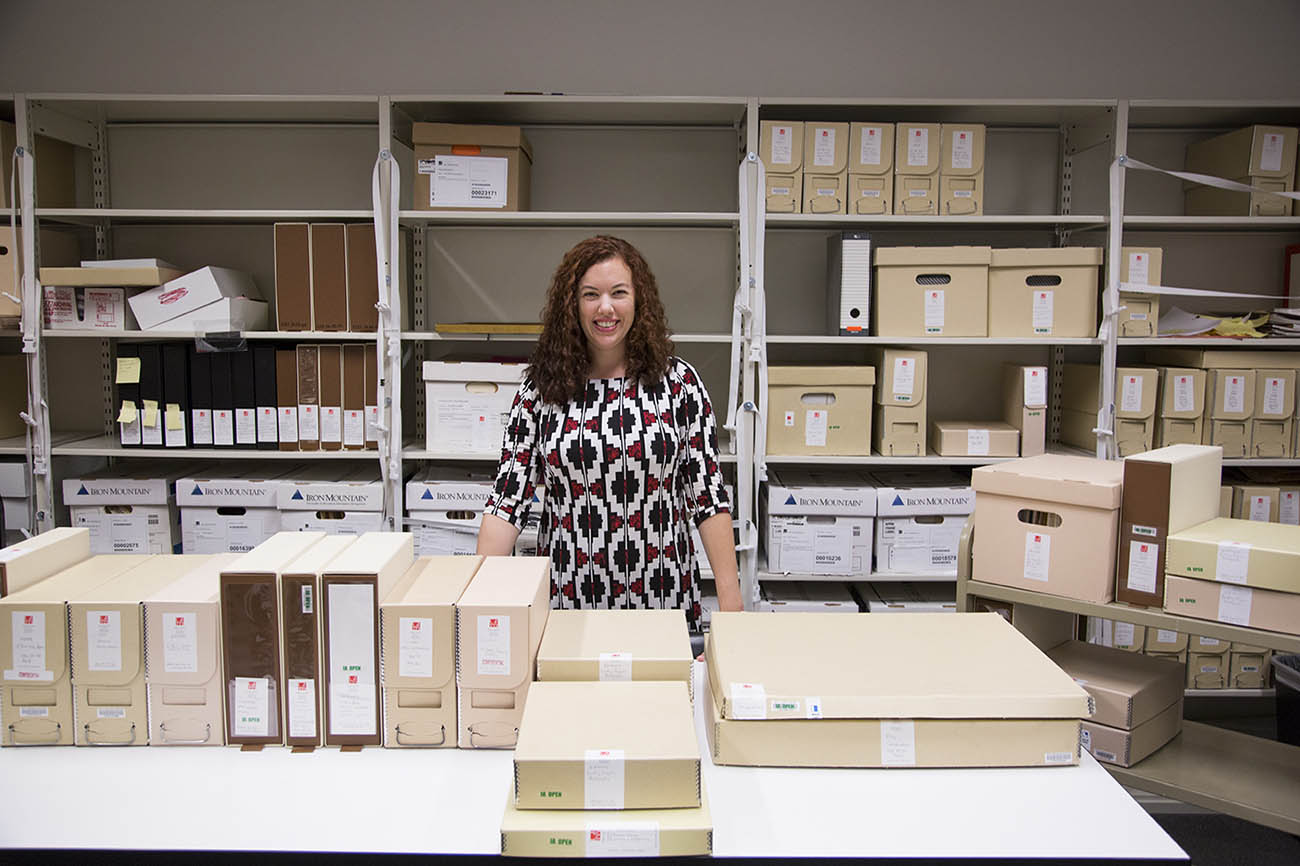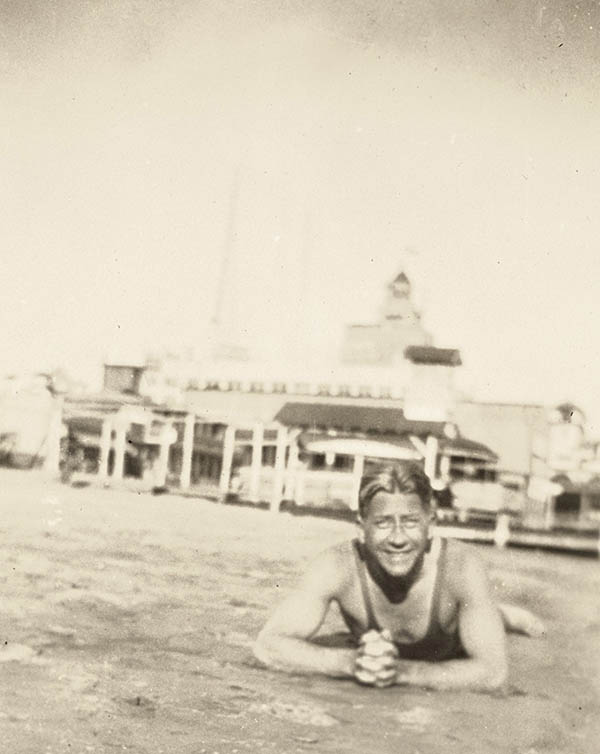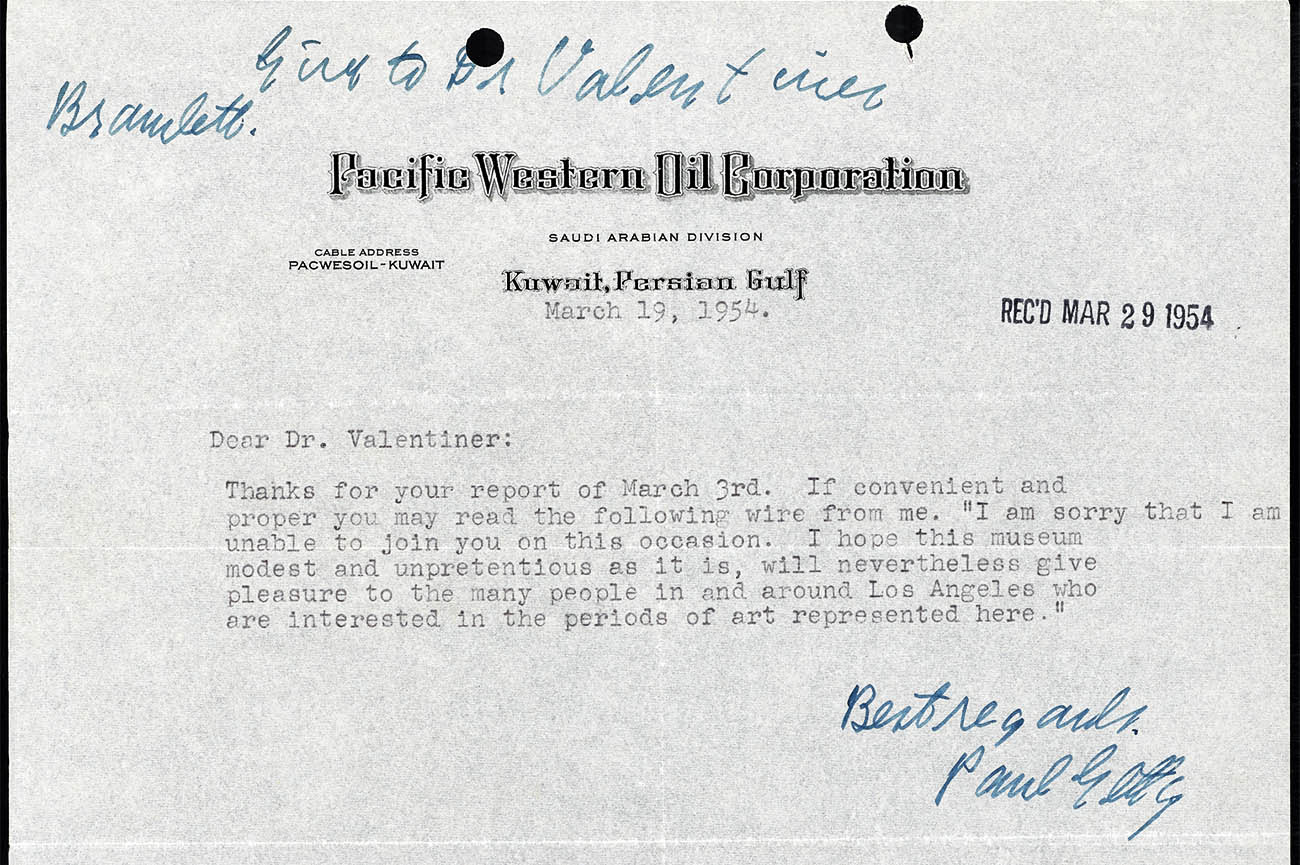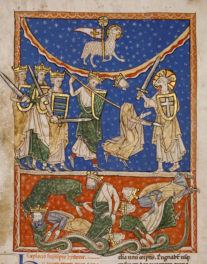How does an institution tell the story of its founder? This was the challenge a team of curators, designers, and content wranglers like myself faced as we prepared the new Getty Museum installation J. Paul Getty: Life and Legacy.
While many books have been written by and about the billionaire oil tycoon who gave his name and fortune to the J. Paul Getty Trust, an engaging presentation of the man and his lasting contribution to the arts cannot rely on published sources alone. Fortunately, records preserved in the Getty’s Institutional Archives offer a firsthand glimpse into the world of J. Paul Getty and his institution, and are featured throughout the installation. As the institutional archivist working on this project, I connected curators with resources from the archives to ensure a compelling and historically rich story was told.

The author amidst boxes from the J. Paul Getty Trust Institutional Archives.
Research on Getty’s Life
The primary purpose of the Institutional Archives is to collect and preserve the historical business records of the Getty Trust. But it also acquires select manuscript collections that pertain to J. Paul Getty. These collections include his personal and business papers, diaries, and photographs of Getty, his family, and his collections. These documents were the main focus of the Life and Legacy project, and were readily available to me thanks to the work of my predecessors who had thoughtfully arranged and described the collections in finding aids that facilitate identifying and locating resources.
Given the volume of the Getty-related papers, I met regularly with curators to help narrow the scope of research. Project meetings allowed me to learn about the goals for the installation and map them to relevant materials in the archives. The team frequently consulted archival documents to verify or clarify assertions made in the publications that were central to the research process, or provide additional historical context. We also explored new information about the founder from records like an unfiled 1950 will and little-known documentary film about Getty and his museum.
To complement the installation narrative that evolved over the course of the project, the team selected images from collections to appear in the gallery. For example, Getty’s diaries represent his art acquisitions and travels through his own voice. Photographs showcasing early displays of Getty’s collection in his Ranch House museum, as well as key events, places, and people in Getty’s life, illustrate many anecdotes.

J. Paul Getty at the beach in Santa Monica, about 1916-19. Institutional Archives, The Getty Research Institute.
Research on Getty’s Legacy
The Trust’s business records supported the legacy of J. Paul Getty: Life and Legacy, which focuses on the expansion and further development of the Museum and larger Getty Trust after Getty’s death. The Institutional Archives contains collections documenting the construction of both the Getty Villa and Getty Center campuses, events that generated photographic, architectural, design, audiovisual, financial, legal, and other business records. Photographic materials from these collections were again the most heavily used resource, as was the documentary film Concert of Wills: Making the Getty Center, for which the archives has master and raw footage.

Letter from J. Paul Getty to W.R. Valentiner with message for opening of the J. Paul Getty Museum, March 19, 1954. Institutional Archives, Getty Research Institute, Los Angeles (1986.IA.55). © J. Paul Getty Trust
Finding these resources for the use of the curatorial team was in many instances only the first step in using them in the final installation. We also had to determine the copyright status of the materials. When necessary, I looked through our accession files to see if any information was documented in contracts or donation agreements, as well as, in the case of photographs, looked for indications of copyright or photographer statements. In many cases, additional research was required by Getty rights and reproductions experts.
As J. Paul Getty: Life and Legacy involves an interactive media display, we also needed to make our holdings available in digital form. The vast majority of our archival collections either have not been digitized, or the existing digital image did not meet the specifications of the project. This meant many of the items selected as visual assets had to be sent to the Getty Research Institute’s Digital Services department to be professionally photographed and output in the requested format. The Getty Research Institute’s audiovisual conservator also digitally reformatted film footage stored on legacy formats such as beta tape, both for reference viewing and final gallery use. These colleagues were essential in helping to bring the archives out of boxes and into the gallery.
J. Paul Getty: Life and Legacy demonstrates the research value and potential of the Getty’s Institutional Archives, and underscores the importance of archival resources to preserving and interpreting organizational history. The manuscript collections consulted for the installation include the J. Paul Getty Family Collected Papers, the Collected Papers for Biography of J. Paul Getty, the J. Paul Getty Diaries, and the Ranch House Records. Trust collections include the Getty Villa Construction Records and Getty Center Site Planning and Construction Photographs. These collections are available for research at the Getty Research Institute. Check the individual collections’ finding aids for any access restrictions.





Comments on this post are now closed.